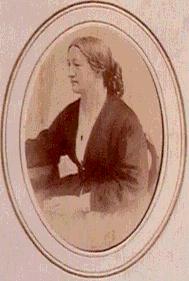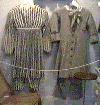Elizabeth Smith Miller - New York History Net
 Elizabeth
Smith Miller was the daughter of Gerrit Smith and
his second wife, Ann Carroll Fitzhugh. She was born
September 20, 1822, and in 1843 married Charles Dudley Miller.
She was a lifelong advocate and financial supporter of the women's rights
movement. Elizabeth
Smith Miller was the daughter of Gerrit Smith and
his second wife, Ann Carroll Fitzhugh. She was born
September 20, 1822, and in 1843 married Charles Dudley Miller.
She was a lifelong advocate and financial supporter of the women's rights
movement.
The Smith home in Peterboro was a station in the Underground Railroad. In
1837, Elizabeth Smith and her father's cousin
Elizabeth Cady, and others, were
introduced to the fugitive slave Harriet Powell and afforded the opportunity to
speak to her for hours about her experience. Such meetings were frequently
arranged by Gerrit Smith to introduce his family and friends to the realities of
slave life, and thereby encourage them in Abolitionist efforts.
Elizabeth and Charles Dudley Miller lived in the Cottage Across the Brook,
which was later occupied by their son Gerrit Smith Miller. They later moved to
Geneva where she lived until her death. While living in Geneva, she authored a
book on home economics.
After her father's death, she cooperated with his first biographer, Octavius
Brooks Frothingham. When Frothingham's treatment
of Smith's relationship with John Brown failed to meet with her approval, she
ordered the books recalled and pages removed. A second edition was prepared
under her supervision with the offending material altered.
 Elizabeth Smith
Miller is best known for the fact that she first wore the outfit of Turkish
pantaloons and knee length skirt popularized by
Amelia Bloomer in
The Lily. Though more ornate,
it is similar to outfits (pictured here) then worn by women at the Oneida
Community, pictured here, as well as the outfits worn by the women of the Oneida
Nation. Elizabeth Smith
Miller is best known for the fact that she first wore the outfit of Turkish
pantaloons and knee length skirt popularized by
Amelia Bloomer in
The Lily. Though more ornate,
it is similar to outfits (pictured here) then worn by women at the Oneida
Community, pictured here, as well as the outfits worn by the women of the Oneida
Nation.
Dress reform was a significant focus of concern among early women's rights
activists, and was strongly advocated in the Smith household. Rebellion against
the fashion of the day, requiring women to dress in voluminous and constraining
outfits, was both a practical necessity and a focal point of social reform. The
"Bloomer" outfit was worn for some time by most of the leaders in the
women's rights movement. It was altered many times, and ultimately abandoned
because of the amount of attention given to its criticism in the popular press.
Following is a description, taken from the Elizabeth Smith Miller collection of
the New York Public Library:
I am asked to give a statement of my experience in adopting wearing, and
abandoning the short skirt.
In the spring of 1851, while spending many hours at work in the garden, I
became so thoroughly disgusted with the long skirt, that the
dissatisfaction--the growth of years--suddenly ripened into the decision that
this shackle should no longer be endured. The resolution was at once put into
practice. Turkish trousers to the ankle with a skirt reaching some four inches
below the knee, were substituted for the heavy, untidy and exasperating old
garment.
Soon after making this change, I went to Seneca Falls to visit my cousin
Mrs. Stanton. She had so long deplored with me our common misery in the toils
of this crippling fashion, that this means of escape was hailed with joy and she
at once joined me in wearing the new costume. Mrs. Bloomer, a friend and
neighbor of Mrs. Stanton, then adopted the dress, and as she was editing a paper
in which which she advocated it, the dress was christened with her name. Mrs.
Stanton and I often exchanged visits and sometimes travelled together. We
endured, in various places, much gaping curiosity and the harmless jeering of
street boys. In the winter of 1852 and 1853, when my father was in congress, I
was also in the cosmopolitan city of Washington, where I found my peculiar
costume much less conspicuous. My street dress was a dark brown corded silk,
short skirt and straight trousers, a short but graceful and richly trimmed
French cloak of black velvet with drooping sleeves, called a "cantatrice"--a
sable tippet and a low-crowned beaver hat with a long plume.
I wore the short dress and trousers for many years, my husband, being at all
times and in all places, my staunch supporter. My father, also gave the dress
his full approval, and I was also blessed by the tonic of Mrs. Stanton's
inspiring words: "The question is no longer [rags], how do you look, but
woman, how do you feel?"
The dress looked tolerably well in walking standing and walking, but in
sitting, a more awkward, uncouth effect, could hardly be produced imagined--it
was a perpetual violation of my love of the beautiful. So, by degrees, as my
aesthetic senses gained claimed the ascendancy, I lost sight of the great
advantages of my dress--its lightness and cleanliness on the streets, its
allowing me to carry my babies up and down stairs with perfect ease and safety,
and its beautiful harmony with sanitary laws--, consequently the skirt was
lengthened several inches and the trousers abandoned. As months passed, I
proceeded in this retrograde movement, until, after a period of some seven
years, I quite "fell from grace" and found myself again in the bonds
of the old swaddling clothes--a victim to my love of beauty.
In consideration of what I have previously said in regard to fashion, I feel
at liberty to add that I do not wear a heavy, trailing skirt, nor have I ever
worn a corset; my bonnet shades my face; my spine was preserved from the bustle,
my feet from high heels; my shoulders are not turreted, nor has fashion clasped
my neck with her choking collar.
All hail to the day when we shall have a reasonable and beautiful dress that
shall encourage exercises on the road and in the field--that shall leave us the
free use of our limbs--that shall help and not hinder, our perfect development.

|